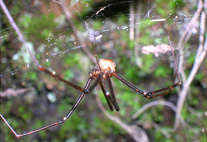Abstract
The atyid genus Micratya Bouvier, 1913 was previously considered to be monotypic. The area in which the genus is dis-tributed is limited to the islands of the Antilles and Central America, with the type locality of Micratya poeyi being in Cuba. A recent molecular phylogenetic analysis of atyid shrimps from the Caribbean indicated the probable existence of a second species of Micratya from samples collected in Puerto Rico. Here it is described as the new species Micratya cooki sp. nov., differing from its congener in the armature of the dactyli on the fifth pereiopod, the uropodal diaeresis, the distal margin of the telson and by the spinulation of the appendix masculina in male specimens. Because the type specimens of M. poeyi are most probably lost, a neotype for M. poeyi was designated.
References
Abele, G.L. & Kim, W. (1989) The Decapod Crustaceans of the Panama Canal, Smithsonian Contributions to Zoology, Number 482.
Bouvier, E.-L. (1909a) Les Crevettes d’eau douce de la famille des Atyidés qui se trouvent dans l’ile de Cuba. Bulletin du Muséum national d’Histoire naturelle, Paris, 329–335.
Bouvier, E.-L. (1909b) Sur l’origine et l’évolution des Crevettes d’eau douce de la famille des Atyidés. Comptes Rendus des Séances de l’Académie des Sciences, Paris, vol 148, 1727–1730.
Bouvier, E.-L. (1913) Sur la classification des Crevettes de la famille des Atyidés. Bulletin de la Sociéte entomologique de France, Paris, 177–182.
Bouvier, E.-L. (1925) Recherches sur la morphologie, les variations, la distribution géographique des crevettes des la famille des Atyides. Encyclopédie Entemologique, serie A, IV: 1–370 (323–327).
Chace, F.A. jr. & Hobbs, H.H.jr. (1969) The Freshwater and Terrestrial Decapod Crustaceans of the West Indies with Special Reference to Dominica. Smithsonian Inst. Bulletin, 292.
Cook, B. D., Bernays, S., Pringle, C.M. & Hughes, J.M. (2009) Marine dispersal determines the genetic population structure of migratory stream fauna of Puerto Rico: evidence for island-scale population recovery processes. Journal of the North American Benthological Society, 28, 709–718. http://dx.doi.org/10.1899/09-008.1
Costa, F. O., deWaard, J. R., Boutillier, J., Ratnasingham, S., Dooh, R. T., Hajibabaei, M. & Hebert, P. D. N. (2007) Biological identifications through DNA barcodes: the case of Crustacea. Canadian Journal of Fisheries and Aquatic Sciences, 64, 272–295. http://dx.doi.org/10.1139/f07-008
Debrot, A.O. (2003) The freshwater shrimps of Curacao,West Indies, (Decapoda, Caridea), Crustaceana 76 (1), 65–76. http://dx.doi.org/10.1163/156854003321672836
De Grave, S. & Fransen, C.H.J.M. (2011) Carideorum Catalogus: The Recent Species of the Dendrobranchiate, Stenopodidean, Procarididean and Caridean Shrimps (Crustacea: Decapoda) Zool. Med. Leiden 85, 196–588.
Guèrin-Méneville, F.E. (1855) Articulata. In Ramon de la Sagra, Historia fisica politica y natural de la Isla de Cuba, vol VIII, Atlas de zoologia, Paris, Tab 1–3.
Guèrin-Méneville, F.E. (1857a) Crustaceos. In Ramon de la Sagra, Historia fisica politica y natural de la Isla de Cuba, vol VII, Crustaeos, Aragnides é Insectos, Paris, I–XXXII.
Guèrin-Méneville, F.E. (1857b) Crustacés. Animeux articulés à pieds articulé. In Ramon de la Sagra, Histoire physique, politique et naturelle de l’Ile deCuba, Paris, I–LXVIII.
Holthuis, L.B. (1955) The recent genera of the Caridean and Stenopodidean shrimps (Class Crustacea, Order Decapoda, Supersection Natantia) with keys for their determination, Rijksmuseum van natuurlijke Historie te Leiden, Zoologische Verhandelingen, 26
Holthuis, L.B. (1977) On some freshwater and terrestrial Crustacea Decapoda from Cuba, Résultats des expéditions biospéologiques Cubano-Roumaines à Cuba, 271–275.
Ivey, J. L. & Santos, S.R. (2007) The complete mitochondrial genome of the Hawaiian anchialine shrimp Halocaridina rubra Holthuis (Crustacea: Decapod: Atyidae). Gene 394, 35–44. http://dx.doi.org/10.1016/j.gene.2007.01.009
Karge, A. & Klotz, W. (2008) Süßwassergarnelen aus aller Welt, Dähne Verlag, Ettlingen, p. 120.
Page, T.J., Choy, S.C. & Hughes, J.M. (2005) The Taxonomic Feedback Loop: symbiosis of morphology & molecules. Biology Letters, 1, 139–142. http://dx.doi.org/10.1098/rsbl.2005.0298
Page, T.J., Cook, B.D., von Rintelen, T., von Rintelen, K. & Hughes, J.M. (2008) Evolutionary relationships of atyid shrimps imply both ancient Caribbean radiations and common marine dispersals. Journal of the North American Benthological Society, 27(1), 68–83. http://dx.doi.org/10.1899/07-044R.1
Schmitt, W.L. (1935) Crustacea Macrura and Anomura of Porto Rico and the Virgin Islands. Scientific Survey of Porto Rico and the Virgin Islands 15(2), 125–227.
Spamer, E.E. & Bogan, A.E. (1994) Type Specimens of Crustacea Surviving in the Guérin-Méneville Collection, Academy of Natural Sciences of Philadelphia, Proceedings of the Academy of Natural Sciences of Philadelphia, 145, 35–46.
Torati, L.S., De Grave, S., Page, T.J. & Anker, A. (2011) Atyidae and Palaemonidae (Crustacea: Decapoda: Caridea) of Bocas del Toro, Panama, Check List, 7 (6), 798–805.
Torati, L.S. & Mantelatto, F.L. (2012) Ontogenetic and evolutionary change of external morphology of the neotropical shrimp Potimirim (Holthuis, 1954) explained by a molecular phylogeny of the genus. Journal of Crustacean Biology, 32, 625–640. http://dx.doi.org/10.1163/193724012X635322
von Rintelen, K., Page, T.J., Cai, Y., Roe, K., Stelbrink, B., Kuhajda, B.R., Iliffe, T., Hughes, J.M. & von Rintelen, T. (2012) Drawn to the dark side: a molecular phylogeny of freshwater shrimps (Crustacea: Decapoda: Caridea: Atyidae) reveals frequent cave invasions and challenges current taxonomic hypotheses. Molecular Phylogenetics and Evolution, 63, 82–96. http://dx.doi.org/10.1016/j.ympev.2011.12.015

